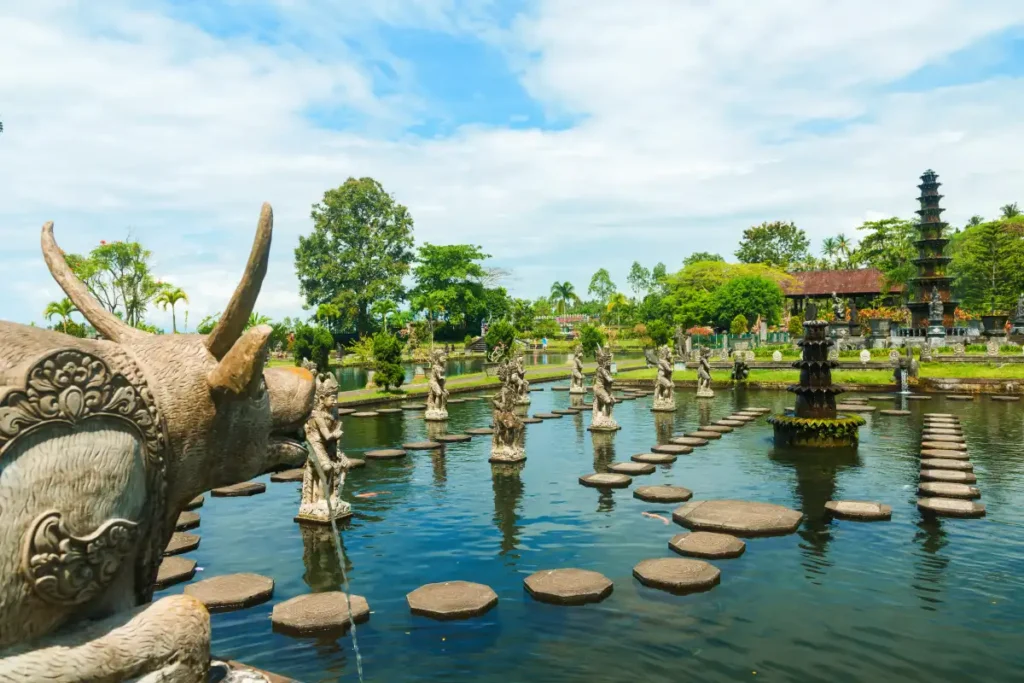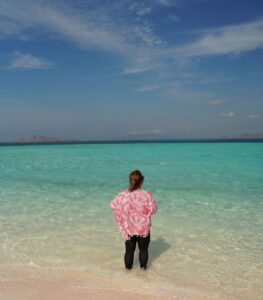
Bali is more than just beaches, rice terraces, and sunsets. It’s an island deeply rooted in spirituality, and nowhere is this more evident than in its iconic water temples. These sacred places are not only stunning examples of Balinese architecture, but they also play a vital role in the spiritual and agricultural life of the island. Visiting a water temple in Bali is an experience that blends culture, serenity, and breathtaking beauty. It’s something every traveler should consider adding to their itinerary.
In this guide, you’ll explore what water temples are, which ones are the most famous and worth visiting, what to expect, and how to prepare for a respectful and fulfilling experience.
Table of Contents
ToggleWhat Is a Water Temple in Bali?
The Balinese Hindu belief system views water as a purifier and life-giver, essential in both spiritual and practical life. Water temples (known locally as Pura Tirta or Pura Air) are designed around natural springs or water sources, and they play a key role in religious ceremonies, water blessings (melukat), and the island’s Subak irrigation system, a UNESCO-recognized method of cooperative rice farming.
Water temples are where locals come to pray, cleanse their bodies and souls, and make offerings to the gods. Tourists are welcome at many of these temples, and visiting them provides an intimate glimpse into the spiritual life of Bali.
Read also: Bali Hinduism: What Makes It Different & Unique
The Most Famous and Beautiful Water Temples in Bali
While there are many sacred water temples across the island, a few stand out not only for their religious importance but also for their architectural beauty and cultural richness. Here are the ones you shouldn’t miss.
1. Tirta Empul Temple – The Most Iconic Water Temple in Bali
Located in the village of Manukaya, near Tampaksiring in central Bali, Tirta Empul is by far the most famous water temple on the island, and for good reason.
Founded in 962 A.D., Tirta Empul is dedicated to Vishnu, the Hindu god of water. The temple is built around a natural spring believed to have healing properties. Its name translates to “Holy Spring,” and it’s best known for its ritual purification pools, where rows of water spouts pour crystal-clear spring water into long stone basins.
Visitors, both locals and foreigners, line up to undergo the melukat purification ritual, moving from one spout to the next, dipping their heads under the flow to cleanse themselves physically, mentally, and spiritually. The sensation of the cool spring water, the sound of flowing streams, and the scent of incense in the air create a surreal, meditative atmosphere.
Travel Tips:
Best time to visit: Early morning (8–9 AM) to avoid the crowds.
What to bring: A change of clothes, a towel, and a sarong (can be rented on-site).
Entrance fee: Around IDR 50,000 for adults.
2. Ulun Danu Beratan Temple – A Floating Sanctuary on the Lake
Ulun Danu Beratan is arguably the most photogenic temple in Bali. Located on the shores of Lake Beratan in the mountain town of Bedugul, this water temple appears to float on the lake’s surface, especially in the morning mist.
Dedicated to Dewi Danu, the goddess of lakes and rivers, Ulun Danu Beratan is both a water temple and a vital spiritual center for Balinese agriculture. The still waters of the lake, combined with the misty mountains in the background, give the temple a mystical, serene ambiance that feels like stepping into a dream. It’s a great stop for travelers exploring central or northern Bali, and is surrounded by gardens, cool highland air, and scenic viewpoints.
Travel Tips:
Best time to visit: Morning, especially before 10 AM for fewer crowds and clear views.
What to bring: A light jacket (cooler temperature), camera, and comfortable walking shoes.
Entrance fee: Around IDR 75,000.
You can also rent a swan-shaped paddle boat or canoe to get a different perspective of the temple from the lake.
3. Tirta Gangga – Royal Water Palace of Eastern Bali
While not a temple in the traditional sense, Tirta Gangga is a royal water palace that holds deep spiritual and cultural value. Located in Karangasem, this site was built in 1946 by the King of Karangasem as a retreat and spiritual sanctuary.
Tirta Gangga features spring-fed pools, fountains, and ornamental gardens set against the backdrop of Mount Agung. Visitors are welcome to stroll through the beautifully landscaped grounds, feed the koi fish, or even take a dip in the bathing pools.
Though you won’t find priests or purification rituals here as in Tirta Empul, the site’s historical and spiritual energy is palpable. It’s a peaceful place to reflect, take photos, and learn more about Bali’s royal past.
Travel Tips:
Best time to visit: Late afternoon for golden hour photos.
Entrance fee: Start from IDR 50,000.
Bring small change to buy fish food or pay for swimming.
4. Pura Taman Ayun – The Royal Water Garden of Mengwi
Tucked in the quiet village of Mengwi in Badung Regency, Pura Taman Ayun is one of Bali’s most elegant and architecturally refined temples. Built in the 17th century by the Mengwi royal family, the temple is surrounded by a wide moat and landscaped gardens, hence the name “Taman Ayun,” which means “Beautiful Garden.”
The temple’s multi-tiered meru towers (pagoda-like shrines) stand tall above the courtyards, symbolizing different layers of the Balinese cosmos. As a royal temple, Taman Ayun served as the family temple of the Mengwi Kingdom, and it’s still used for important ceremonial offerings.
Strolling through the tranquil paths beside lotus ponds, visitors will experience a calm, peaceful vibe quite different from the crowded tourist temples.
Travel Tips:
Best time to visit: Late morning or early afternoon.
What to bring: Sarong (can be rented at the entrance), water bottle.
Entrance fee: Around IDR 30,000.
Nearby attraction: Sangeh Monkey Forest, just 15 minutes away.
5. Goa Gajah – The Elephant Cave with Sacred Pools
Located just outside Ubud, Goa Gajah, or the Elephant Cave, is a mysterious site that combines ancient cave carvings, meditation spots, and bathing pools fed by sacred springs.
Dating back to the 11th century, the entrance to the cave is carved with mythical creatures and demons, an iconic photo spot. Outside the cave, visitors will find fountains flanked by stone nymphs pouring water into bathing pools, believed to be sacred and used for spiritual cleansing. Though not strictly a water temple, the presence of holy water fountains and ritual baths ties it closely to Bali’s water purification traditions.
Travel Tips:
Best time to visit: Early morning or late afternoon to avoid tour buses.
What to bring: Sarong, sturdy footwear (some uneven paths).
Entrance fee: Start from IDR 50,000.
Respectful clothing is a must, even when it’s hot
6. Pura Gunung Kawi Sebatu – A Hidden Gem with Tranquil Springs
Often overshadowed by its more famous cousin Gunung Kawi in Tampaksiring, Pura Gunung Kawi Sebatu is a lesser-known but deeply serene temple nestled in lush forest near Tegallalang, just north of Ubud.
Dedicated to Vishnu and the water deity, the temple is built around natural mountain springs. Sacred koi-filled ponds, moss-covered statues, and tranquil purification pools give it a dreamlike, spiritual atmosphere without the heavy tourist traffic. This is a perfect spot for those seeking a meditative experience or simply a quiet connection to Bali’s sacred water traditions.
Travel Tips:
Best time to visit: Morning or after lunch for solitude.
Entrance fee: Start from IDR 30,000.
Don’t miss: Feeding the fish with food sold on-site.
7. Pura Beji Sangsit – Northern Bali’s Subak Guardian
Located in Sangsit village in North Bali (Buleleng), Pura Beji is a beautiful temple dedicated to Dewi Sri, the goddess of rice and fertility. Unlike the mountainous water temples of central Bali, this one has deep ties to Bali’s ancient subak (irrigation) system and farming culture.
Pura Beji is built in a unique style typical of northern Bali, with intricate floral and vine stone carvings covering nearly every inch. Though it lacks a purification pool, it remains an important “water temple” due to its role in blessing the water flowing through the rice paddies.
Travel Tips:
Best time to visit: Morning, especially if you’re staying in Lovina.
Entrance fee: Donation-based (bring small cash).
Nearby highlight: Visit the quiet black-sand beaches of Lovina.
8. Pura Luhur Batukaru – Sacred Springs on Bali’s Second-Highest Volcano
Situated on the misty slopes of Mount Batukaru in Tabanan, Pura Luhur Batukaru is one of Bali’s most sacred mountain temples and is deeply connected to nature and water. This temple is surrounded by rainforest and features fresh mountain springs that flow into bathing areas used for purification.
As a directional temple (one of Bali’s Sad Kahyangan), Batukaru plays a key role in protecting the island. Water here is considered extremely pure due to its origin from the mountain, many locals collect it for rituals. Its isolated setting and cool mountain air create a sense of deep spirituality and peace.
Travel Tips:
Best time to visit: Morning or just after rain for misty vibes.
What to bring: Jacket, sarong, water-resistant shoes.
Entrance fee: around IDR 40,000
This temple is often missed by tourists, making it ideal for mindful travelers.
9. Pura Tirta Sudamala – A Hidden Purification Haven
Tucked away near Bangli, Pura Tirta Sudamala is a spiritual sanctuary that remains under the radar for most tourists. This peaceful site features a riverside temple with a series of fountains used by locals for the melukat purification ritual.
The temple’s sacred water comes from a spring near the river, cascading from intricately designed spouts. Bathing here is often a more intimate, authentic experience compared to busier temples like Tirta Empul. The surrounding forest and riverbanks make it feel like a hidden retreat, ideal for self-reflection and spiritual renewal.
Travel Tips:
Best time to visit: Early morning (before local ceremonies begin).
Entrance fee: Donation-based around IDR 10,000 – 20,000.
Recommended for: Visitors seeking off-the-beaten-path experiences.
10. Pura Taman Mumbul – A Hidden Gem for Spiritual Cleansing
Tucked away in the quiet village of Sangeh, just north of Ubud, Pura Taman Mumbul remains one of Bali’s most serene and lesser-known water temples. Surrounded by lush jungle and towering bamboo groves, this sacred site centers around a natural spring and large pond that locals believe holds purifying and rejuvenating powers.
Unlike the bustling crowds you’ll often find at more famous temples, Pura Taman Mumbul offers a more intimate and meditative experience. Its crystal-clear pond is often used for melukat (spiritual cleansing) rituals, where locals quietly immerse themselves in the sacred waters with offerings and prayers. The stillness of the water, the sound of birds in the trees, and the peaceful ambiance make this a perfect retreat for travelers seeking reflection or a deeper cultural connection.
Stone steps lead down to the edge of the spring, where you’ll see ancient statues of guardian deities peeking through the moss. The temple’s name, “Mumbul,” means bubbling, referring to the natural spring that gently bubbles from underground, a visual symbol of spiritual awakening and life force.
Travel Tips:
Best time to visit: Mid-morning or late afternoon for soft lighting and quiet surroundings. The temple rarely sees large tourist groups.
What to bring: Sarong and sash (mandatory, can be rented nearby), change of clothes if participating in purification, and small offerings if you wish to join the rituals respectfully.
Entrance fee: Donation-based around. IDR 10,000 – 20,000.
Read also: 10 Best Temple to visit in Bali for a Temple Hopping Trip
What You Need to Know When Visiting Bali’s Water Temples
- Modest Clothing: Always wear a sarong and sash (most temples offer rentals). Shoulders and knees must be covered out of respect.
- Change of Clothes: Especially for temples where purification rituals involve full immersion.
- Cash: Entrance fees are usually paid in cash. Small denominations are also useful for donations or offerings.
- Waterproof Bag: To keep your valuables dry if you participate in melukat.
- Camera: Photography is allowed in most areas, but be respectful during ceremonies.
- Respect for Rituals: Avoid stepping over offerings (canang), and do not interrupt or film ceremonies without permission.
What to Expect and What to Avoid
Expect:
Spiritual Atmosphere: Even if you’re not religious, the peaceful energy is palpable.
Local Ceremonies: If you’re lucky, you might witness a traditional Balinese offering or prayer session.
Natural Beauty: Most water temples are surrounded by lush greenery, rivers, or lakes.
Avoid:
Entering Sacred Areas During Menstruation: According to Balinese Hindu beliefs, women on their period should not enter temple grounds.
Climbing on Structures: Temples are sacred spaces, respect their architecture.
Being Loud or Disruptive: Maintain a peaceful demeanor and volume.
A Journey Beyond the Surface
Exploring Bali’s water temples isn’t just about visiting beautiful places, it’s about immersing yourself in the island’s deep spiritual rhythms, ancient traditions, and sacred waters that continue to nourish both land and soul. Whether you’re standing in awe at the dramatic setting of Pura Ulun Danu Beratan, taking part in a cleansing ritual at Tirta Empul, or discovering the peaceful serenity of Taman Mumbul, each temple offers a unique window into Balinese culture and its profound connection to nature.
So, pack your sarong, bring a respectful heart, and let Bali’s water temples guide you into a journey that flows far beyond the surface. Ready to experience the spiritual heart of Bali? Add at least one of these stunning water temples to your itinerary!






